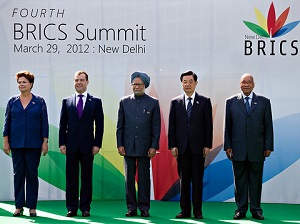 (28 July 2013)
Are the BRICS really broken? There has been a lot of talk recently
about declining growth in emerging markets especially in four largest
countries collectively known as the BRIC nations (Brazil, Russia, India,
China). South Africa was recently added to the original four. A new article by Ruchir Sharma
of Morgan Stanley has suggested that the BRICs time in the spotlight
may now be over after shining so brightly in the 2000s. China's double
digit annual growth is now a thing of the past, and Brazil is seeing
widespread social unrest against a backdrop of rising inflation and
economic stagnation. Russia is riddled with corruption and remains an
undiversified oil-based economy. Like its fellow BRIC brethren, India
has seen its growth rates moderate from 9 percent down to 6 percent this
year as struggles with inflation and inadequate infrastructure are
formidable obstacles to sustainable economic growth.
(28 July 2013)
Are the BRICS really broken? There has been a lot of talk recently
about declining growth in emerging markets especially in four largest
countries collectively known as the BRIC nations (Brazil, Russia, India,
China). South Africa was recently added to the original four. A new article by Ruchir Sharma
of Morgan Stanley has suggested that the BRICs time in the spotlight
may now be over after shining so brightly in the 2000s. China's double
digit annual growth is now a thing of the past, and Brazil is seeing
widespread social unrest against a backdrop of rising inflation and
economic stagnation. Russia is riddled with corruption and remains an
undiversified oil-based economy. Like its fellow BRIC brethren, India
has seen its growth rates moderate from 9 percent down to 6 percent this
year as struggles with inflation and inadequate infrastructure are
formidable obstacles to sustainable economic growth. What does the future hold for India? Are its recent setbacks merely very normal growing pains as an economy undergoes a process of maturation? Or is the current phase of sluggish growth a warning signal of more significant problems to come as development is blocked by poor infrastructure and a political system that is ill-equipped to deal with long-term challenges?
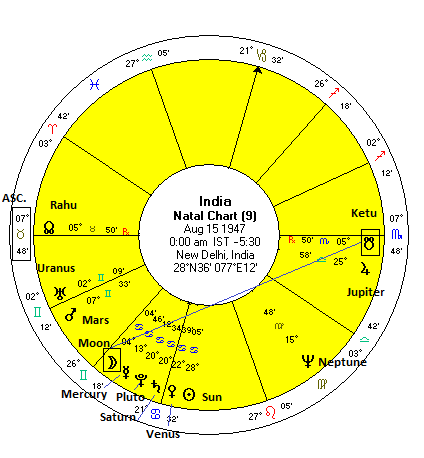
A look at the horoscope of India provides a unique window on this question. We can see that India gained independence in 1947 during its Saturn dasha. For most of its first forty years, Indian adhered to a somewhat socialist model of development which emphasized protectionism, price supports, and a highly regulated marketplace. This Fabian approach supposedly protected the bulk of the population from the vagaries of the free market and reduced inequality. However, it also also dampened entrepreneurship and innovation and produced very slow growth. It also did little to reduce endemic levels of poverty throughout the country. Perhaps it is not surprising that this socialistic model should have been followed during Saturn's dasha period since that planet is said to symbolize the broad mass of the population, especially in the democratic sense of "the people". Saturn is also generally seen as a difficult energy where growth comes slowly if at all and austerity is favoured over spending. And at the risk of stretching the planetary metaphor too far, Saturn is the planet of planning and orderliness -- a very apt reflection of the preference for a statist planned economy replete with many nationalized industries.
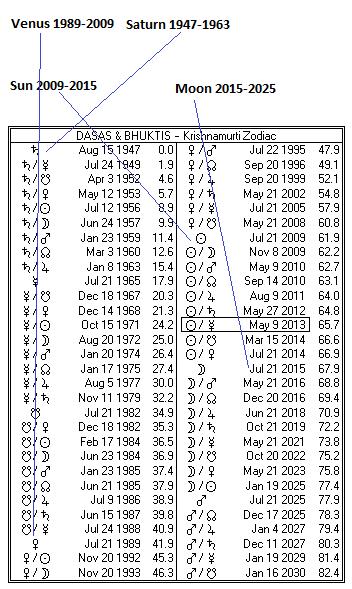
India's political elites finally changed course in 1991 as the economy was liberalized and opened up to more competition. Economic growth increased significantly as a result of this new initiative as hundreds of millions of people joined the middle class. Interestingly, liberalization occurred at the beginning of the Venus dasha (1989-2009). Venus is a very different influence than Saturn as it typically emphasizes enjoyment, luxuries, money and pleasure. Venus is a benefic planet and its dasha periods are often times of greater happiness, enjoyment and expansion. This is a very appropriate description of what happened to the Indian economy at this time as the consumer sector exploded with the newly-minted middle classes buying all manner of automobiles, electronics and real estate. It is worth noting, however, that liberalization has done little to improve the lot of the bottom third of India's population. This may be a reflection of the condition of Venus in the natal chart which is tightly conjunct Saturn. Saturn tends to enforce limits and moderate prosperity, even when it is associated with a benefic planet like Venus. In this sense, the more difficult position of Venus in the India horoscope may be one reason why the mostly positive Venus dasha period did not produce more growth than it did. As has been well-documented, India has lagged far behind China during its liberalization phase.
The Sun dasha began in 2009 and will run until 2015. We can see that the Sun is in a somewhat mixed condition in the chart as it is closely conjunct Venus and Saturn. The Venus influence is mostly positive but Saturn tends to make things more difficult. The Sun is slightly malefic in nature and its rulership of the 4th house mitigates some of that negativity. This mixed picture is perhaps appropriate given the nature of economy in the past few years. While India has rebounded quite well from the 2008 economic meltdown, the recovery has been uneven. Inflation is still a problem as is the increasing current accounts deficit and the falling rupee. The stock market rebounded from the depths of 2008 but it has gone mostly sideways for the past two years and has not been able to break above the all-time high set in January 2008.
The current situation offers the possibility of some guarded optimism. Since May, the Sun-Mercury dasha has been running and this will remain in effect until March 2014. Mercury is generally supportive of economic growth since it rules commerce although its its ability to do good is moderated by its presence in the 3rd house with Saturn and Pluto. From the perspective of the dasha periods, we could see moderate growth and measured progress in the near term.
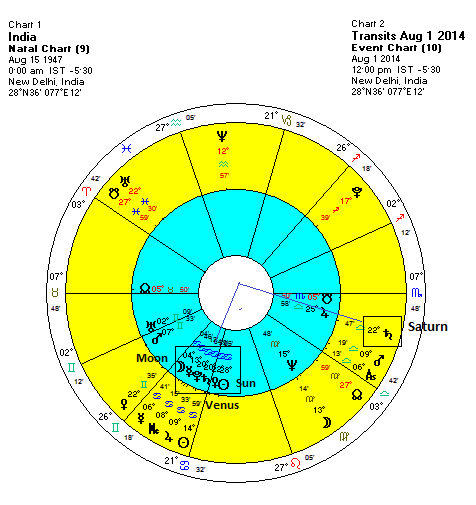
The problem, however, is with the transit chart. Saturn is currently transiting sidereal Libra. This sets up an ongoing square aspect to all of those planets in Cancer in the Indian national horoscope. This is generally an unfavourable influence, especially since it aspects Mercury, 2nd house lord of wealth, Venus, the 1st house lord and karaka of wealth and happiness and the Sun, which represents the government and vitality of the nation as a whole. This Saturn transit will be in effect through all of 2014 and presents a very significant astrological impediment to growth and renewed confidence in the future. For the next couple of months, Saturn will be squaring the natal Mercury so this may depress commercial activity and cause transportation and communication problems. The presence of this very difficult transit over the next year when the dasha period is mixed at best suggests that India is unlikely to resume its breakneck pace of economic growth in the near future. The best-case scenario would appear to be more muddling through.
Looking further ahead, the Moon dasha begins in 2015 and will run for 10 years until 2025. Like the Sun, the Moon is in mixed condition in the horoscope. Its placement in the sign of Cancer is very auspicious and denotes a greater capacity for positive outcomes. However, the close aspect from Ketu is problematic here and suggests the Moon dasha may be volatile. Moon-Ketu aspects can bring about sudden changes and generally are not conducive to periods of stable and strong economic growth. While gains are still likely, growth may be uneven and interrupted and may cause anxiety and uncertainty, both for the economy and the political system.
The bottom line from this admittedly very brief overview is that India's horoscope suggests that uncertainty and uneven economic growth is more likely to be the norm in the next ten years. Part of this moderated growth may be explained in terms of "regressing to the mean" after several years of very high growth. However, I suspect that the Indian economy may have to cope with additional burdens that make it unlikely to repeat its early honeymoon period of the 2000s when it entered the BRIC club.
On financial markets last week, US stocks held steady as corporate earnings reaffirmed faith in the recovery. The Dow was unchanged closing at 15,543. Indian markets fared worse, however, as earnings disappointed against a backdrop of Asian slowing. The Sensex tumbled 2% closing at 19,748.
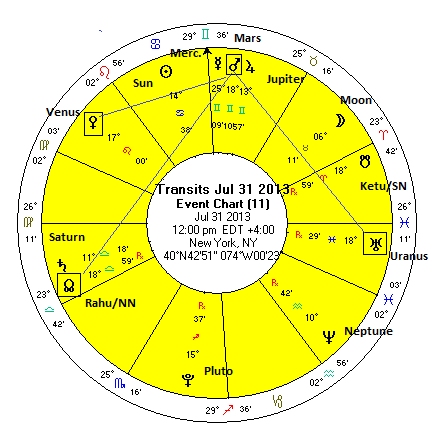
The planets this week look somewhat more exciting than last week. This is perhaps not unexpected anyway as Ben Bernanke is scheduled to speak on Wednesday after the latest FOMC meeting and there is the July jobs report due on Friday which could impact when the Fed decides to taper its QE bond purchases. Monday's Sun-Saturn aspect offers the possibility of some bearishness in the early part of the week. The midweek tilts a little bullish as Venus forms an aspect with Pluto. The late week looks more significant, however, as Mars squares Uranus (bearish) on Thursday and Friday just as it approaches an aspect with Venus (bullish) and Rahu (bearish). There is quite a bit of energy in this pattern although it is not readily apparent which direction it could move markets. However, I am generally cautious around any alignments that involve Mars and Rahu since both planets are malefics.